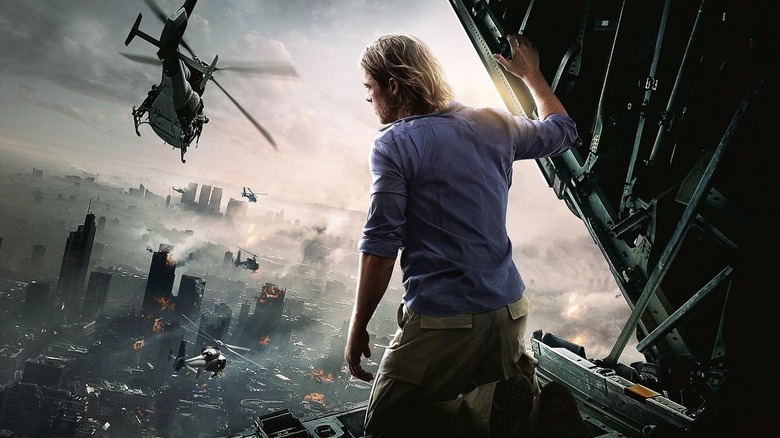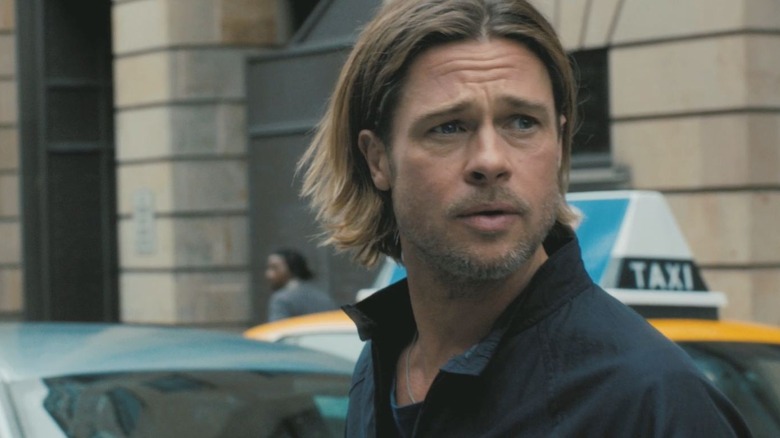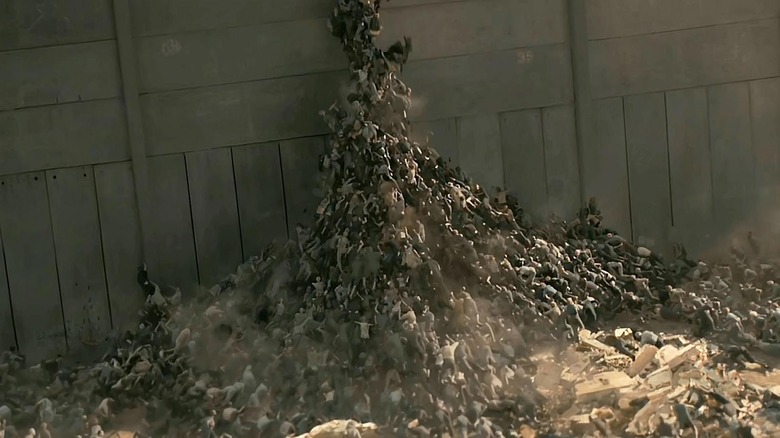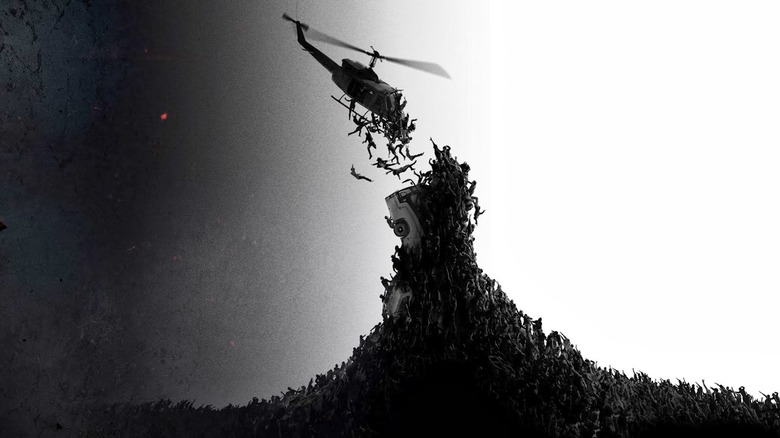This Is The Most Expensive Horror Movie Ever Filmed
The early 2000s were a magical time for zombie fans, as there was a zombie boom the likes of which hadn't been witnessed since the rise of post-"Night of the Living Dead" rip-offs in the 1970s. Presaged by the popularity of '90s video games like "Resident Evil" and "The House of the Dead," a new slew of zombie feature films hit theaters and hit hard. There was a "Resident Evil" film in 2002, which was followed by six sequels. Danny Boyle sparked the debate between "slow zombies" and "fast zombies" with his low-fi post-zombie-apocalypse film "28 Days Later" (which had a sequel). Zack Snyder's remake of "Dawn of the Dead" rattled the zeitgeist in 2004 (which kinda had a sequel, kinda). George A. Romero — the master himself — returned to zombies in 2005 with "Land of the Dead" (which had two follow-ups). Edgar Wright and Simon Pegg were canonized into the geek firmament with the release of "Shaun of the Dead." By the time the hot TV series "The Walking Dead" debuted on AMC in 2010, zombies were semi-permanently entrenched deeply in the popular consciousness.
Feeding into this matrix was Max Brooks' playful 2003 parody book "The Zombie Survival Guide," which laid out practical directions on how to traverse the world following a zombie outbreak. After the real-life horrors of 9/11, it certainly felt like a relief to face an apocalypse that one could handle with little more than guns, a working car, and knowledge of pop culture movie monsters. The success of "Survival Guide" led Brooks to write a 2006 follow-up called "World War Z: An Oral History of the Zombie War," which was inspired, in structure, by 1984 Pulitzer Prize-winning book "The Good War: An Oral History of World War II" by Studs Turkel.
"World War Z" was a massive success, and led to a feature film in 2013 starring Brad Pitt and put out by his production company. The feature film cost $190 million dollars to make (according to Box Office Mojo). As Chris Rock's Cheap Pete would say, Good Lord, that's a lot of money! Zombie films, up the this point, were notoriously cheap to make; usually all you needed was an abandoned mall, some game extras to wear "dead" makeup, a fistful of cow intestines, and a lot of red-dyed Karo syrup. Why did "World War Z" cost so much?
Plan Z
Because zombie films were so hot, Brooks' novel was optioned for film adaptation almost immediately, and as early as 2007, Plan B and Leonardo DiCaprio's production company Appian Way became embroiled in a bidding war for the rights. The idea of making a zombie movie on a global scale — complete with zombie hordes overwhelming the landscape — was appealing from a production standpoint, as a zombie film with a mainstream Hollywood blockbuster budget hadn't been tried since ... ever? And whether Pitt or DiCaprio ended up landing the rights to "World War Z," it would also be the first zombie blockbuster to feature a bankable Hollywood leading man.
Coming up with a film-friendly script for "World War Z" was a trial, as one might be able to intuit from the fact that it has four credited screenwriters and two "story by" credits.
The original novel was an epistolary, you see, telling its story from the "found" records and in-person interviews of various people from all around the world who had survived the zombie uprising. But if the movie was going star a notable actor like Brad Pitt, it needed a central perspective. The first rendition of the screenplay, written by sci-fi luminary J. Michael Straczynski, was highly praised by the internet pundits who had managed to read a leaked version (which may be taken with a grain of salt, as said pundits tend to speak in a language of superlatives), and the Straczynski screenplay ended up on The Black List survey in 2007 as one of the best screenplays that hadn't yet been produced. The original idea was to tell a zombie film from a more terse, on-the-ground perspective, and Straczynski compared his work to "The Bourne Identity." This terse-ification of pop action entertainment was very in vogue in the early 2000s.
Two years later, it was announced that the Straczynski screenplay was being re-written by Matthew Michael Carnahan ("Lions for Lambs," "State of Play"). Carnahan, given his previously-produced screenplays, was meant to keep the Straczynski terseness in place, but altered in ways that have not been revealed. By 2011, pre-production began in earnest, with shooting beginning in Malta.
Despite this, there were still arguments within the production company over the script, which was described as being abrupt and incoherent. After production, screenwriter Damon Lindelof ("Prometheus," "Star Trek Into Darkness") was hired to re-work the film's entire third act. The story goes that he and Pitt were able to find a better script in the version already in production, but Lindelof had to leave before he could actually rework the ending, and passed the completion duties to Drew Goddard ("Buffy the Vampire Slayer," "Cloverfield"). This was after a version of the movie had already been ostensibly finished.
It's a Dead World After All
The global scale of "World War Z" was a huge contributing factor to its enormous budget, and scenes of thousands of zombies crawling all over each other like ants, forming chains and bridges with their bodies, required extensive special effects. The film also shot all over the world, with shooting locations in Malta, Hungary, and the United States, as well as army bases in Wales, England, and Scotland. Given the size of the production, "World War Z" was already an expensive production — the film was initially budgeted at $125 million — but all the aforementioned script troubles led to extensive reshoots (including an all-new ending) that caused the budget to mushroom to at least $190 million. If one believes rumors passingly mentioned in certain entertainment magazines at the time, the budget may have even reached as much as $269 million, although that number has not been substantiated by Paramount.
Reshoots on gigantic A-productions are not uncommon, of course, and most big-budget feature films pick up missing shots or add scenes in post-production — news of reshoots are not the gloom-and-doom prognostications some film outlets might have you believe they are. But the reshoots on "World War Z" were particularly expensive, as they were not only used to cover a new ending, but patch over holes left by some rather dramatic last-minute cuts.
Paramount president Marc Evans was reportedly unhappy with a 12-minute scene that took place in Red Square in Moscow (as well as others shot in Budapest) that highlighted the film's original intent to be a bleak sociopolitical thriller along the Straczynski line. Evans wanted the film to be a more generally pleasing blockbuster. The same Red Square sequence also saw Pitt's character — initially an Everyman type — become an indestructible warrior badass, and few seemed pleased with the transition. Most of these dramas are detailed in a behind-the-scenes analysis in Vanity Fair. In that article, the film's second unit director admitted that the film had become way less character-driven by the end, and that it was just the result of the drama that went into production.
Too Rare to Die
"World War Z," then, was poised to be an enormous flop. Brad Pitt and Paramount had poured an enormous amount of money into a bizarre blockbuster gamble, making what was the most expensive horror movie of all time. Before its eventual release in June of 2013, there was scuttlebutt among fans that horror movies could only be scary if dealt with on an intimate scale, and that enormous horror movies were not conducive to evoking fear. Others responded darkly to the film's previews, citing its use of 9/11 imagery to be either in poor taste, or proof positive that citywide destruction could now be allowed back into Hollywood blockbusters — such imagery was typically avoided for a few years out of a sense of good taste.
The film's opening weekend boded well enough, as it opened with a low-end-of-respectable $66 million. It opened just behind "Monsters University," a high-end Pixar animated sequel. Eventually, "World War Z" would shamble along to make just over $200 million domestically. Internationally "World War Z" was far better-attended, making over $330 million overseas, and over half a billion overall. "World War Z" was one of those rare cases of a notoriously troubled production making good on its box office promises. It wasn't too badly reviewed either, currently enjoying a modest 66% approval rating on Rotten Tomatoes.
This was successful enough to push a sequel into the works, and in 2016, star director David Fincher was attached to direct a follow-up with Pitt returning to star. Paramount, however — perhaps remembering the trouble the first film put them through, or maybe sensing that zombies aren't the undead cash cow they once were a decade previous — never actually put it on their schedule, and eventually the project was scrapped.
Zombie films will continue to be made, as the monster still holds appeal for many and the genre is cheap to make, but we may never again see a zombie movie on the scale of "World War Z." No matter how much trouble it was to make, it cannot be denied that it is unique.



